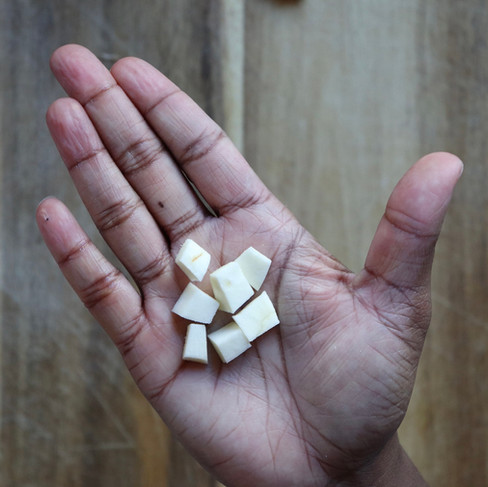PARSNIPS | 6 mos+ |🥇🌈💩
- Priscila Cleary
- Jun 7, 2022
- 10 min read
Updated: Mar 5, 2024

Parsnip are root vegetables that look like carrots. Although they are related to carrots, they are actually more nutritious and taste completely different. As a food for baby, parsnips bring a nice nutty/sweet flavor.
DISCLAIMER: Each child has their own development timeline and specific needs. The content below is general information and for educational purposes only and is not a substitute for professional one-on-one advice. You are responsible for supervising your child’s health and for evaluating the appropriateness of the information below for your child. Please consult your healthcare provider regarding support or advice for your child's well being and health. Never disregard professional medical advice or delay in seeking it because of something you have read or seen here.
Contents
7. How to store parsnips
10. Other FAQ about parsnips
When can I give parsnips to my baby?
Babies can eat parsnips as soon as they are ready to start eating solid foods, which is usually when they are around 6 months of age and have met all the readiness signs for solids, unless otherwise advised by your baby's healthcare provider. Parsnips are easy to digest and do not present a high risk of allergic reaction, making this vegetable a great option for baby’s first food.
You can give your baby a safe start to solid foods! This on-demand workshop will provide you with the knowledge and confidence you need to wean well.
Is parsnip a healthy food for babies?
Parsnips are root vegetables that look like carrots. Although they are related to carrots, they are actually more nutritious and taste completely different. As a food for baby, parsnips bring a nice nutty/sweet flavor.
They are full of nutrients and contain a high percentage of vitamin C. Vitamin C aids in the development of strong bones and muscle. It also works to boost the immune system.The richness in protein, fiber, and calcium makes parsnips even more nutritious food for your baby.
Parsnips are a wonderful source of folate, Thiamine, and vitamin B6, which is essential for the development of a strong nervous system and healthy brain. Vitamin B6 also helps to maintain the sleep cycle of your baby.
The antioxidant properties of parsnips work to improve heart health and body health.
Parsnips aid in digestive issues. If your baby, like many others, suffers from constipation, parsnips can help. They significantly stimulate the bowels. Not to get deeper into the biological terms, the gastrointestinal passage is unblocked because of the high fiber content, making the digestive system work better.
Fun Fact: Parsnips have a long taproot that can grow up to a foot in length and roughly three inches in diameter at the crown. Growing above ground, the plant’s foliage resembles large celery leaves and stems.
Is parsnip a safe food for babies?
Parsnips may contain a natural compound called furocoumarins. It is a protective compound for the plant, but can be a toxic substance to humans. This compound is found in higher amounts in wild parsnips. Furocoumarins concentration is high in the peel or skin of the vegetable.
Parsnips toxicity may cause phytophotodermatitis in some people. It is a skin condition characterized by ashes, red skin, burning, and blister.
Wash the vegetable and cut the damaged part before serving it to your baby. Cooking also helps drop the level of toxicity in the vegetable. You may peel the parsnips to help reduce the risk of toxicity even more. If you see signs of a reaction when introducing parsnips to your baby, consult your pediatrician. See the sections "How to buy" and "How to prepare and offer" for more information about safely offering parsnips to babies.
Is parsnip a choking hazard for babies?
Although parsnips are not listed on CDC's list of most common choking hazards for babies, they can be a choking hazard if offered raw. To reduce the risk, make sure parsnips are cooked to a soft consistency before offering to your baby. And cut the vegetable into safe shapes and sizes to offer to your little one (See “How to prepare and offer” section below for more details).
This workshop covers everything you need to know for dealing with gagging, reducing the risk of choking during mealtimes, and offering safe food sizes and shapes to your child.
Note: Keep in mind that any food can present a risk for choking if not prepared correctly. You are responsible for following age and food modification guidelines provided in order to reduce your baby’s risk for choking.
Is parsnip a top food allergen for babies?
Parsnips allergy is not very common, however, they may cause a reaction because of the presence of substances like Furocoumarins and Sclerotinia sclerotiorum. Signs of a reaction to these compounds can include itch, tingling, or even rashes. Discoloration of skin might occur and is likely to go away after months.
As mentioned before, parsnips allergy is very rare, and the likelihood of babies being affected by these substances that may be present in the vegetable are very low. But it’s a good idea to be more vigilant if your baby has a strong history of allergies.
Whenever you give your baby parsnips (or any other food) for the first time, offer it in small quantities, and watch for any signs of a reaction. If your baby seems to tolerate the food well and you see no adverse reaction, then continue to gradually increase portion sizes when you offer it again to baby. If your baby shows any symptoms like diarrhea, skin hives, abdominal pain, shortness of breath, swelling of mouth, weakness, or dizziness after the consumption of parsnips, consult your healthcare provider. These symptoms can be a sign of parsnips allergy or intolerance.
Note: Always consult with your healthcare provider regarding introducing solid foods to your baby, and specifically discuss any foods that may pose allergy risks for your baby.
How to buy parsnips for babies
Select parsnips as you would select carrots. Even though it looks somewhat like a carrot, a parsnip has pale, cream-shaded skin. Parsnips should not be discolored or have cuts and bruises on them. There should be nothing growing or sprouting from the top of the parsnip, nor should there be little root hairs growing along the veggie itself.
Look for medium-sized ones. Any vegetable in colossal size will not be as tasteful as the medium one. And choose firm parsnips (they shouldn’t be bendy) and buy the ones that are lightest in color, because they tend to have the best texture.
How to store parsnips
Freshly bought parsnips can be stored for up to 2 weeks. You can place them in a zip-lock bag and put the bag in your refrigerator to avoid the parsnips from rotting.
Only cut the parsnips when you are ready to cook or otherwise use them. Cut parsnips do not store very well, but if you must peel and/or cut them, store them in a container and cover them with water. Store for no longer than 2 days. Cooked parsnips can be stored for 3-7 days in the refrigerator.
How to prepare and offer parsnip to babies

To safely offer parsnips to your baby, first wash them thoroughly under cool water. Then trim both ends (as you would with a carrot). You may choose to remove the peel or not. Since the peel is very thin, most babies can manage chewing it without a problem. However, as mentioned before, the peel may contain natural substances produced by the vegetables that could cause a reaction. Note that the cooking process also helps to reduce the concentration of those compounds in parsnips.
You may cut the parsnips before or after cooking. Either way, just make sure to cut them into sizes and shapes that are appropriate for your baby’s age, development stage, and feeding skills (see suggestions below). If you’re preparing parsnips for the very first time, please note that they discolor when cut, just like potatoes. If you won’t be cooking them right away, place cut parsnips in a bowl of water.
You can steam, boil, bake, or roast the parsnips. Steaming is the best way to cook them, as it softens the parsnips and retains all the nutrients. Roasted parsnips in your oven, however, are the most flavorful, and we encourage you to try roasting parsnips as well as other veggies. Whatever cooking method you choose, just make sure they are cooked to a soft consistency that passes the “squish test” (you can easily smash the food between your fingers).
Purees: cook parsnips into a soft texture. Mash them by using a spoon or a fork to make the puree. Add a little water, breast milk, formula milk, or yogurt (if your baby isn't allergic to) to get the texture desired. You can also use a blender or food processor, if you want to. You may also add any desired spices, except salt and sugar. Offer puree via spoon feeding or by preloading a spoon that your baby can bring to their mouth independently.
6+ months: cooked parsnips mashed or puree on a baby spoon or suction bowl
Don't get stuck on purees! It's completely ok to start with only pureed foods, if that feels more comfortable to you. However, keep in mind that purees are just a transitional phase into finger foods. It shouldn't last for more than a few days or a couple of weeks. Aim to start exposing your baby to lumpy and finger foods no later than 8 months, unless otherwise advised by your baby's health care provider.
Finger food 6 to 9 months old: At this age babies are only able to grab food with their whole palm, so the best way to offer parsnips as a finger food to your baby is in the form of cooked parsnip sticks. Cut the vegetable lengthwise in quarters or more to reduce the risk of choking. Make sure sticks are about the length and width of an adult finger.
Baby Z, 6 months, eating roasted parsnips strips
6+ months: cooked parsnips cut into strips or sticks about the size and shape of an adult finger
Avoid coin-shaped pieces, as they are a choking hazard
NOPE BETTER BEST h
Alternatively, you can offer mashed cooked parsnips or parsnip puree on a preloaded spoon that you place on your baby’s tray or hand to encourage self-feeding.
Another option is to grate raw parsnips and add it to cooked preparations. Even if grated, we don’t recommend offering raw parsnips to babies like you could do with raw finely grated carrots. As mentioned before, parsnips may contain Furocoumarins and Sclerotinia sclerotiorum, natural substances produced by the plant that can cause a skin reaction. Cooking the vegetables helps reduce the concentration of those substances in the vegetable.
6+ months: grate raw parsnips and add it to cooked preparations

Finger food 9 to 12 months old: you can continue to offer parsnips as recommended above. However, at this stage, babies begin to use their pincer grasp (thumb and index finger) to pick up small pieces of food, and some babies might not be as interested in stick shapes, so you can move into bite sizes about the size of a garbanzo bean. After cutting the parsnips in julienne strips or quarters, then cut into little cubes. Avoid coin-shaped pieces, as they are a choking hazard. Encourage the use of utensils by preloading a fork with diced cooked parsnips so baby can bring it to mouth on their own.
9+ months: cooked parsnips diced into bite size pieces or half-moon slices
This is also a great stage to start mixing parsnips with other foods and making preparations, since your baby should have already been exposed to a few different foods, and you probably already ruled out some of the possible food allergies or intolerance.
Finger food 12+ months old: continue to offer parsnips as suggested above. Encourage the use of utensils, but don’t force it. Sometimes our little ones get tired of using utensils, and they might prefer to use their hands. This is completely normal!
Toddlers love to dip food, so try serving cooked parsnips sticks with different kinds of delicious dips! Add them to your salads, soups, stews and casseroles. You may use parsnips in place of any other root vegetable in a recipe.
Note: Finger foods are small pieces of food that your baby can pick up and eat easily. Introducing finger foods early, as soon as starting solids, helps your baby get used to different food textures, improves coordination and encourages self-feeding. These are important feeding skills. Babies can enjoy soft finger foods before they have teeth. They can mash foods into smaller pieces using their gums.
⚠️Avoid putting finger foods or whole foods in your baby's mouth for them. Your baby must do this at their own pace and under their own control.⚠️
Parsnip meal ideas for babies:
Add mashed parsnips to babies oatmeal/porridge.
Mash parsnips and beans together and make balls/patties/sausages for self-feeding.
Offer steamed or bakes parsnips strips with a baby-friendly dip.
Make parsnips and fruit puree (pear works great!) and serve by the spoon or use as a spread on bread.
Other FAQ about parsnips
Are parsnips and parsley root the same thing?
Parsnips and parsley root are NOT the same thing… even though they look incredibly similar!
Parsnips are creamy, almost yellowish in color, have a fairly pungent smell, which some people find unpleasant (don’t worry, they don’t taste like they smell!). They have a carrot-like shape, but tend to be more bulbous. They have a sweetish, nutty taste that’s hard to compare to anything else, and are usually used to make purees, roasted with other root veggies, or used in place of carrots. Also, they are rarely sold with leaves attached.
Parsley root (also known as turnip rooted parsley, Dutch parsley, rooted parsley, Hamburg parsley and – confusingly – parsnip rooted parsley) is pale – almost white – in color, and has a clean, fresh aroma. It tends to have a long, slender, tapered shape, and a parsley-like flavor which some compare to celery. This vegetable tastes good mixed with mashed potatoes and can be used in the same way as parsnips or carrots, and it is sold with the leaves (parsley) attached.
When are parsnips in season?
Unlike many other seasonal vegetables, parsnips are your all-rounder. This means they are mostly available throughout the year. Although wintry days favor the growth of parsnips more than the warm ones do. From fall to spring, parsnips can be found in plenty.
★In-season produce is fresher and tastes better, sweeter and perfectly ripe. They also tend to cost less compared to out-of-season produce. Seasonal produce in your area will vary by growing conditions and weather.
Recipes
As always, discuss any concerns with your healthcare provider. This post and this site is not meant to be a substitute for medical advice. The materials and services provided by this site are for informational purposes only.
Library Symbol Legend
Here in our Food Library we use some symbols or emojis to make it easier for you to find what you need. Listed below are the symbols we use and what they mean.
🔥 - this is a high-calorie food. You should include a high-calorie food at each meal.
💪 - this is an iron-rich food. You should include an iron-rich food at each meal.
🌈 - this is a colorful food. You should include a fruit and/or a vegetable at each meal.
🥇 - this food is a great choice for baby's first food.
🌱 - this food is a great choice for plant-based babies.
💩 - this is a food that helps prevent or treat constipation.
🥜 - this food contains peanuts, a common food allergen.
🍳 - this food contains egg, a common food allergen.
🐄 - this food contains cow's milk, a common food allergen.
🌾 - this food contains wheat, a common food allergen.
✳️ - this food contains soy, a common food allergen.
💮 - this food contains sesame seed, a common food allergen.
🌰 - this food contains tree nuts, a common food allergen.
🐠 - this food contains fish, a common food allergen.
🍤 - this food contains shellfish, a common food allergen.
⚠️ - this food is a common choking hazard. Make sure to follow age and preparation guidelines.
★ - tips, tricks, and hacks.
References
Bushell, S. (2020, April 8). Parsnip Puree Baby Food. Weaning | Fussy Eating | The Children’s Nutritionist. Retrieved February 14, 2021, from https://www.childrensnutrition.co.uk/full-recipes/parsnip-puree-baby-food
Choking Hazards. (2021, September 2). Centers for Disease Control and Prevention. Retrieved November 9, 2021, from https://www.cdc.gov/nutrition/infantandtoddlernutrition/foods-and-drinks/choking-hazards.html
Harvard Health. (2021, February 15). The pros and cons of root vegetables. Retrieved April 28, 2022, from https://www.health.harvard.edu/staying-healthy/the-pros-and-cons-of-root-vegetables
Journal, D. S. (2019, August 24). Parsnips: The Healthy Vegetable We’ve Been Missing Out On. Daily Science Journal. Retrieved February 14, 2021, from https://www.dailysciencejournal.com/everything-about-parsnips/#:%7E:text=While%20handling%20and%20cooking%20parsnips,a%20condition%20known%20as%20phytophotodermatitis
Link, M. R. S. (2019, January 18). 6 Nutrition and Health Benefits of Parsnips. Healthline. Retrieved February 14, 2022, from https://www.healthline.com/nutrition/parsnip#TOC_TITLE_HDR_4
Lombaert, G. A., Siemens, K. H., Pellaers, P., Mankotia, M., & Ng, W. (2001). Furanocoumarins in Celery and Parsnips: Method and Multiyear Canadian Survey. Journal of AOAC INTERNATIONAL, 84(4), 1135–1143. https://doi.org/10.1093/jaoac/84.4.1135
Parsnips. (2017, March 5). Foodsafety.Asn.Au. Retrieved February 14, 2021, from https://foodsafety.asn.au/parsnips/
University of California, Agriculture and Natural Resources. (2001, May). Sclerotinia diseases (No. 8042). University of California. https://anrcatalog.ucanr.edu/pdf/8042.pdf
.png)


























.png)
.png)